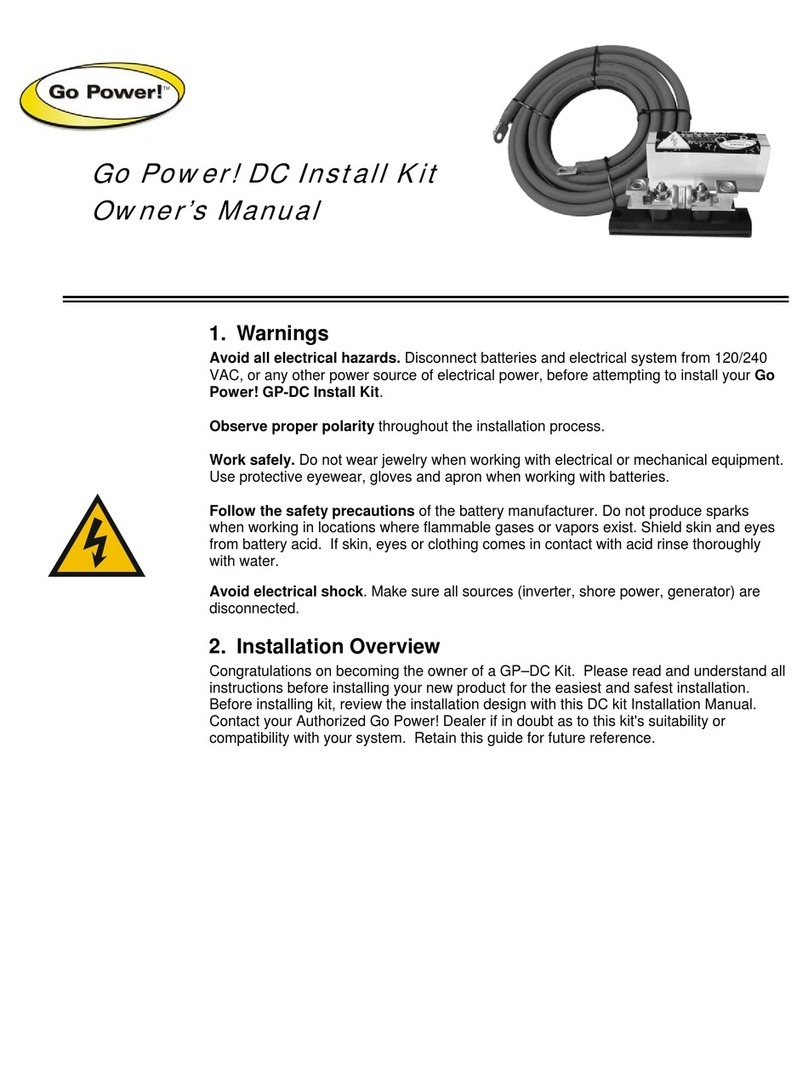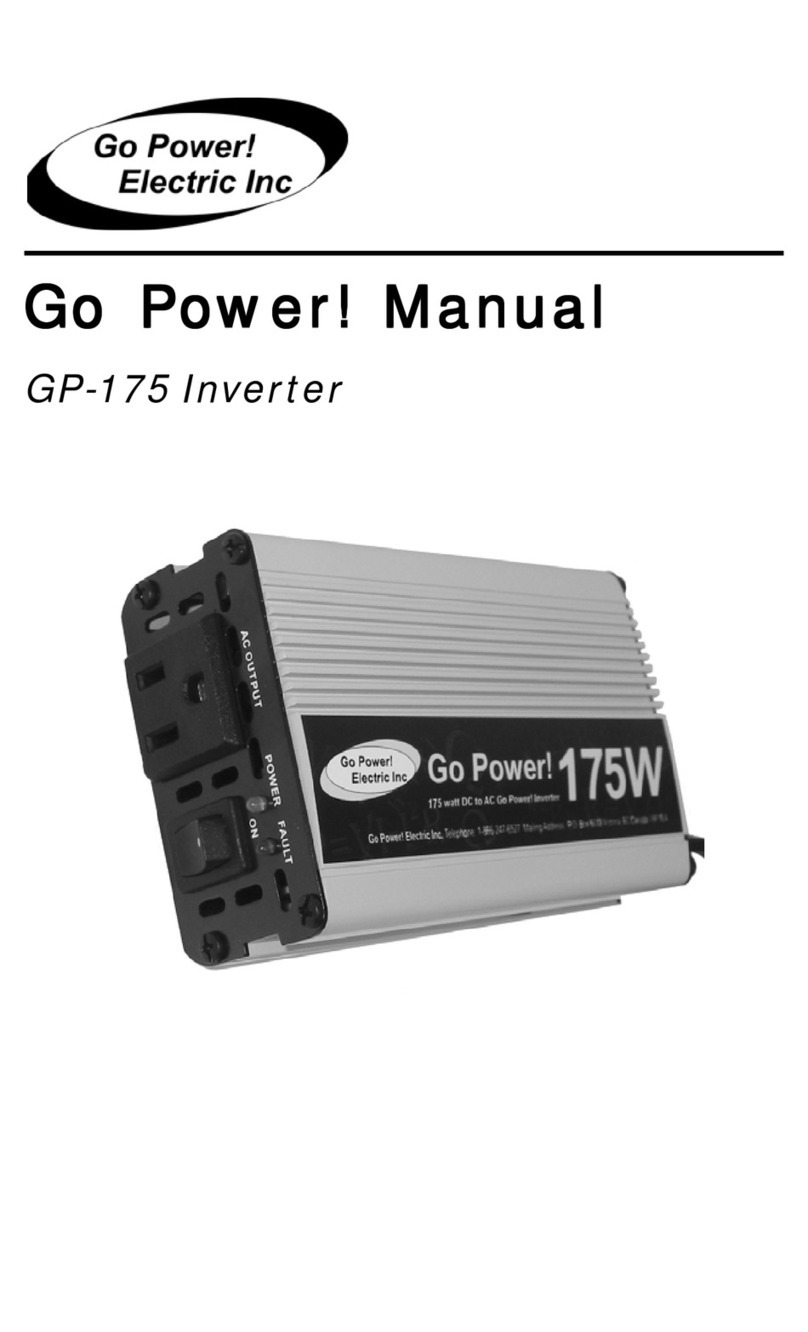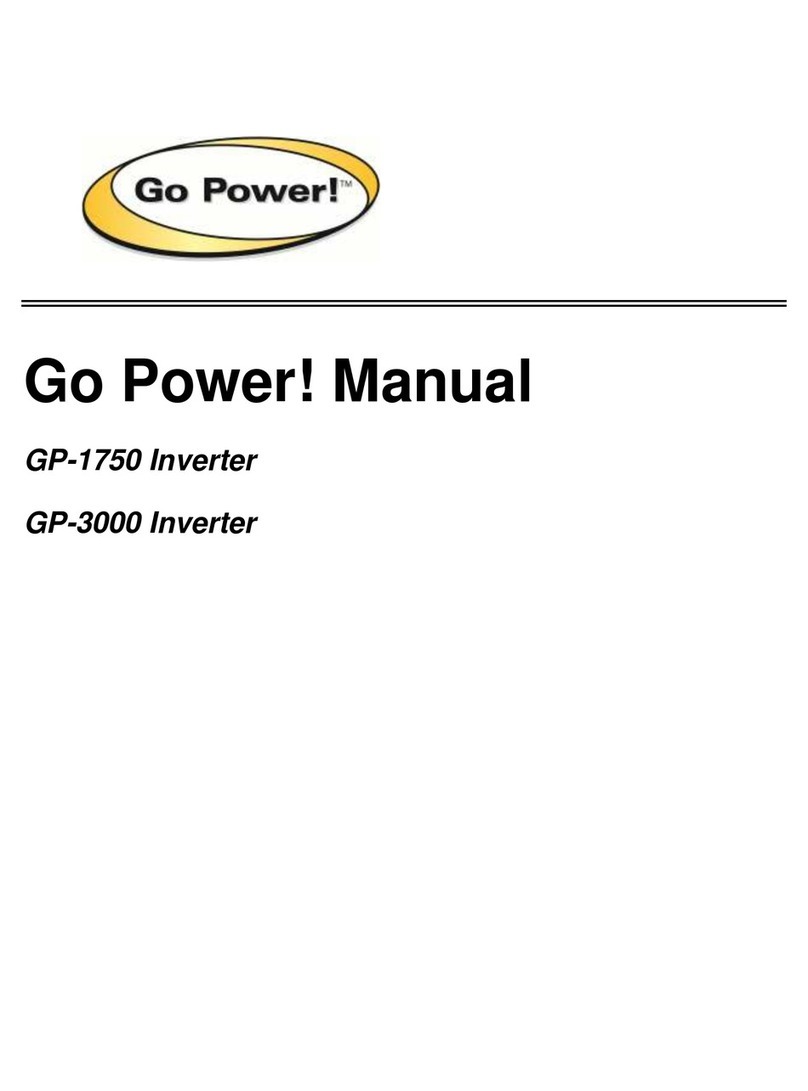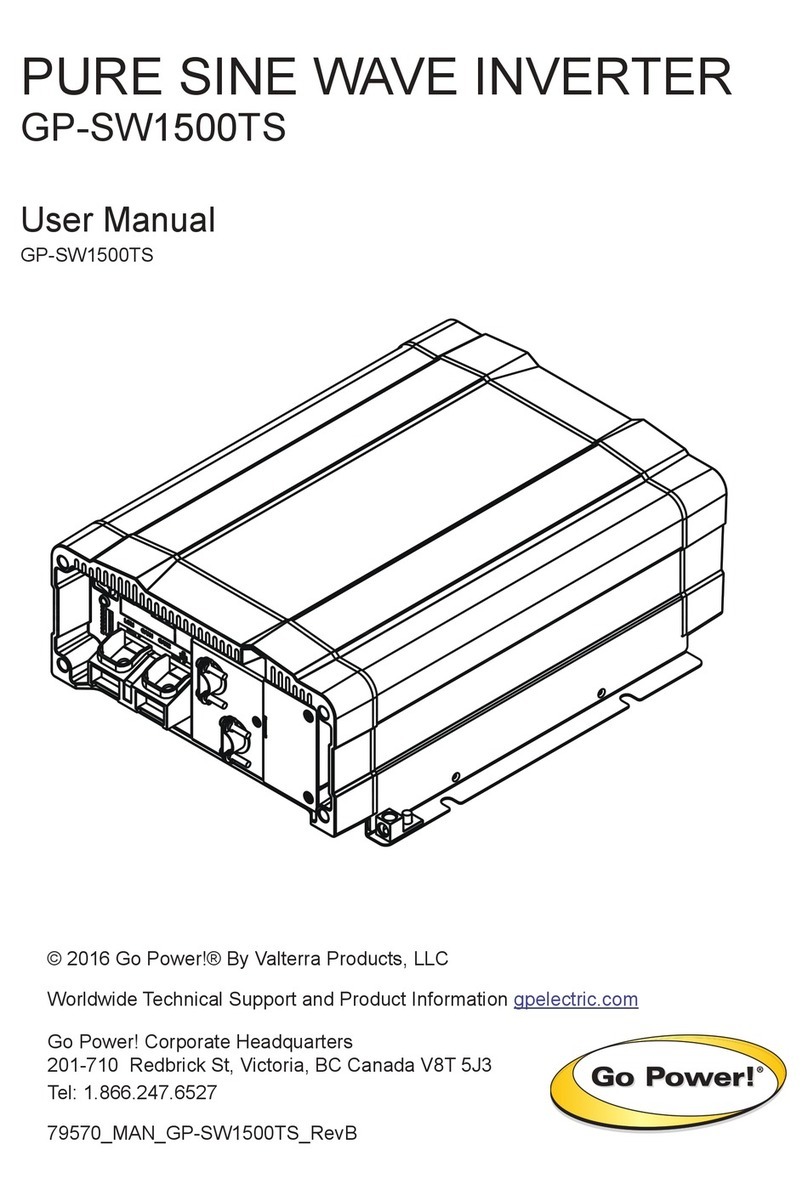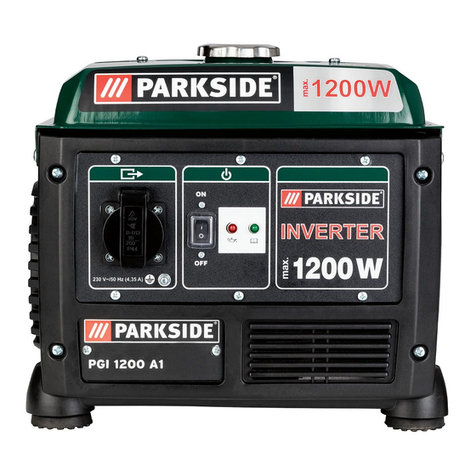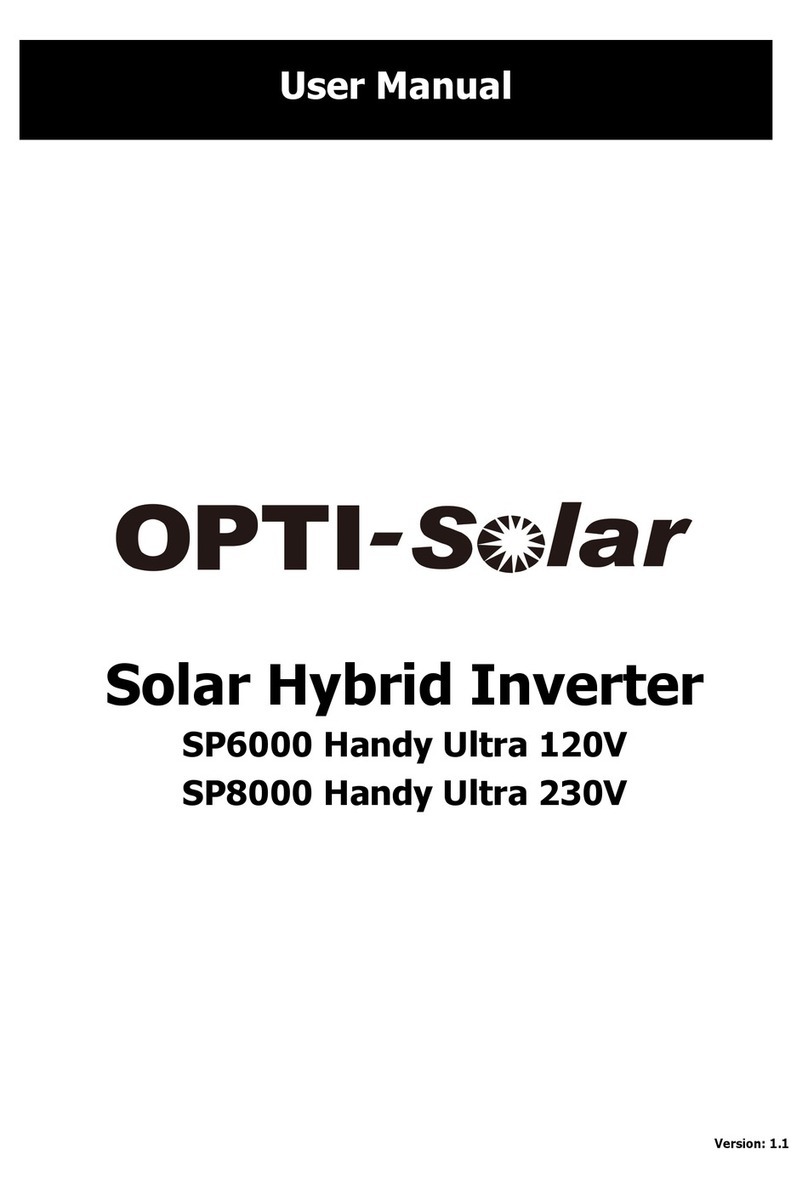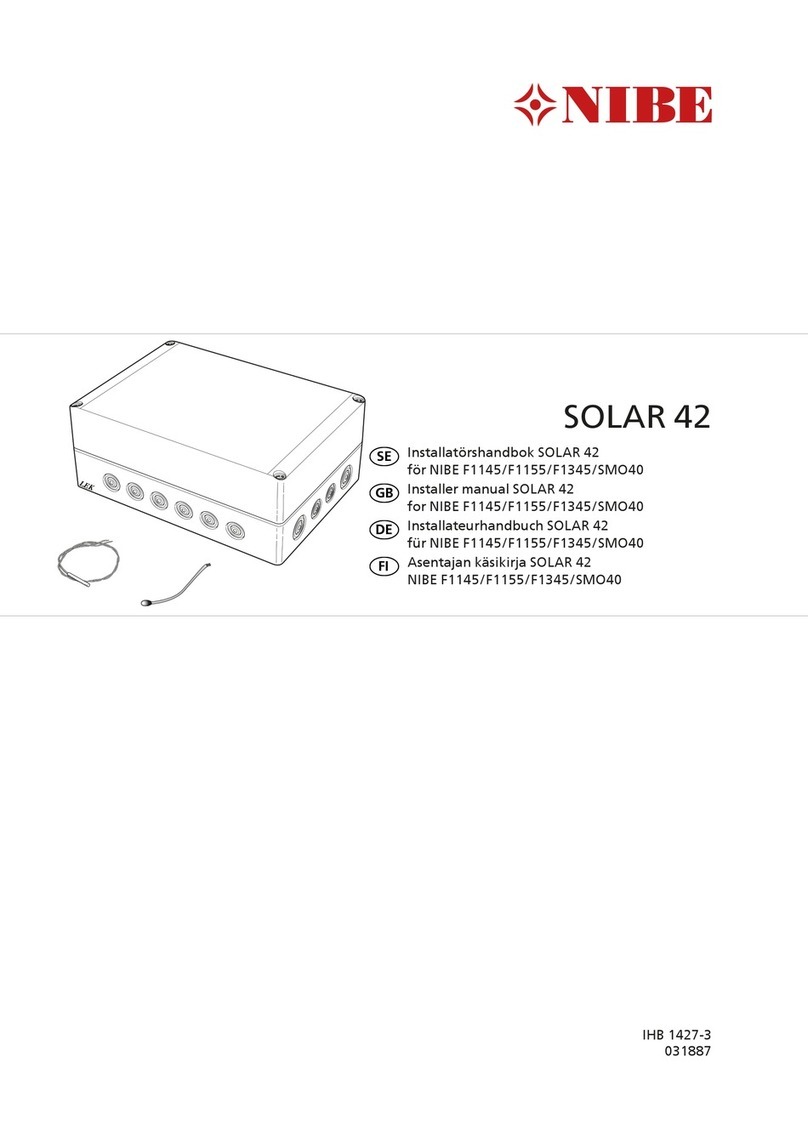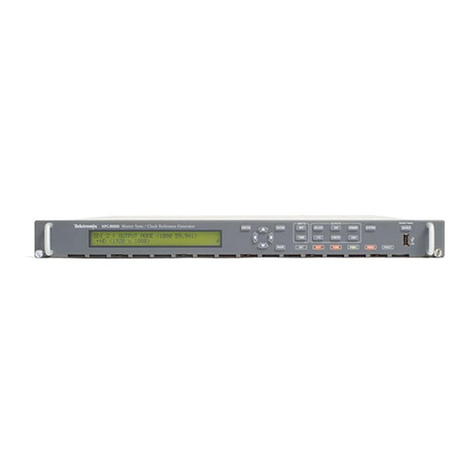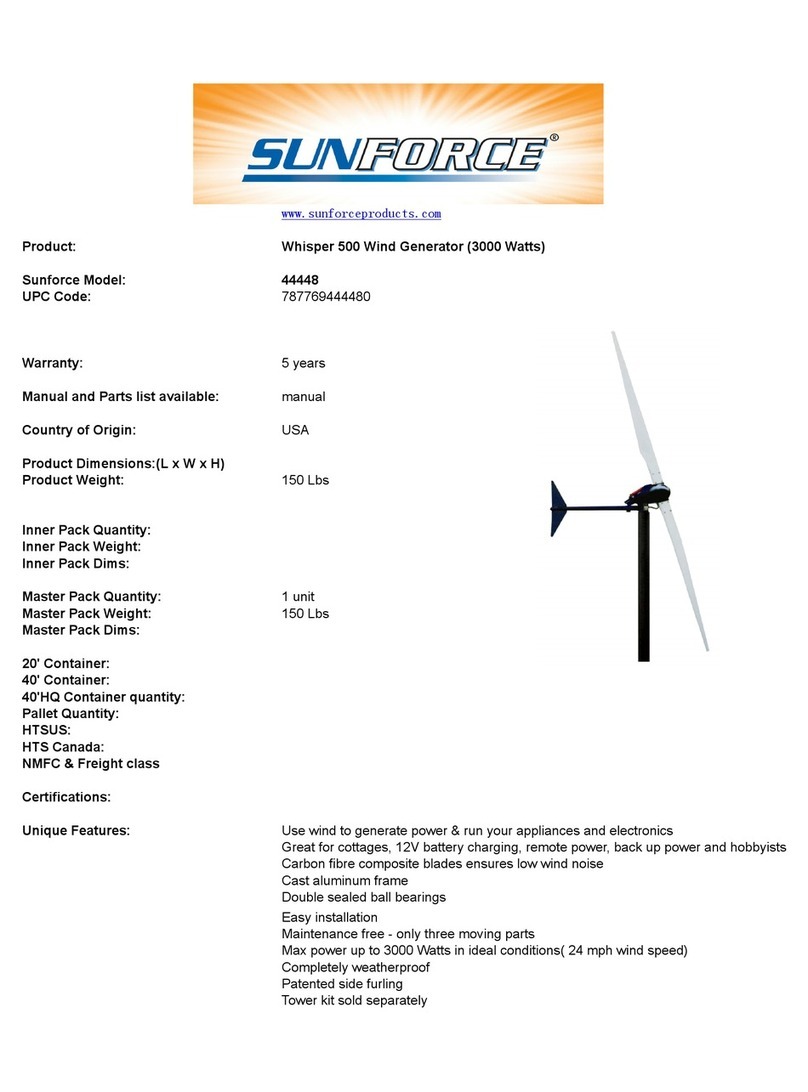Go Power! Electric GP-300 User manual

Go PGo P
Go PGo P
Go Poo
oo
oww
ww
wer! Maner! Man
er! Maner! Man
er! Manualual
ualual
ual
GP-300 Inverter
GoPower!ElectricInc.
PO Box 6033
Victoria, BC V8P 5L4
Tel: 866-247-6527
Fax:866-607-6527
Email:[email protected]

Go Power! Modified Sine Wave Inverter
Owner’s Manual
Table of Contents
1. INTRODUCTION 3
2. SPECIFICATIONS 3
3. FEATURES 4
4. INSTALLATION 5
5. OPERATION 8
6. OPERATING LIMITS 8
7. TROUBLESHOOTING 9
8. MAINTENANCE 10
9. WARRANTY 10
Go Power! Electric Inc.
PO Box 6033
Victoria, BC V8P 5L4
Toll Free Tel: 866-247-6527
Toll Free Fax: 866-607-6527
Email: [email protected]
GoPower!ElectricRev2.2
GPModifiedSW300InstallGuide.doc
211

1. Introduction
The Go Power! Inverter series provides mobile power for people on the go. Run
standard AC appliances wherever you travel. Silent, lightweight and simple to
use, Go Power! Inverters can be used in a wide range of applications including
remote homes, RVs, boats and long haul trucks. It will operate most televisions and
VCR’s, personal computers and small appliances including drills, sanders, grind-
ers, mixers, blenders and microwaves. The inverter must have a greater power
rating than the load to which it is providing power.
To get the most out of your power inverter, it must be installed and used properly.
Please read the instructions in this manual before installing and using
your inverter.
2. Specifications
2.1 GP-300Inverter 12 V
Output 300 W
Output wave form Modified Sine Wave
Output voltage 115 VAC rms
Regulation +5%-10%
DC input voltage 10-15 V
Low battery alarm ± 2% 10.5 V
Low battery shut-down ± 2% 10.0 V
Efficiency 80-90%
Frequency ±1% 60 Hz
No load current 0.2 A
Surge rating 400 W
Over thermal protection Yes
Cooling fan Yes
Overload protection Yes
Dimensions (LxWxH) 118 x 121 x 51 mm
4.7” x 4.8” x 2.0”
Net weight 0.84 kg
1.8 lbs
Inverter Install Kit Included
Go Power! Modified Sine Wave Inverter
Owner’s Manual Go Power! Modified Sine Wave Inverter
Owner’s Manual
10 3
8. Maintenance
Very little maintenance is required to keep your inverter operating properly. You
should clean the exterior of the unit periodically with a dry cloth to prevent accumu-
lation of dust and dirt. At the same time, tighten the screws on the DC input terminals.
9. Warranty
We warrant this product against defects in materials and workmanship for a period
of 12 months from the date of purchase and will repair or replace any defective Go
Power! Inverter when directly returned, postage prepaid, to the manufacturer. This
warranty will be considered void if the unit has suffered any obvious physical
damage or alteration either internally or externally, and does not cover damage
arising from improper use such as plugging the unit into an unsuitable power
sources, attempting to operate products with excessive power consumption
requirements, reverse polarity, or use in unsuitable climates.
This is the only warranty and the company makes no other warranties, express or
implied, including warranties of merchantability and fitness for a particular purpose.
Repair or replacement are your sole remedies and shall not be liable for damages,
whether direct, incidental, special or consequential, even though caused by
negligence or other fault.
Low battery alarm on all the
time, LED indicator is red.
Low battery alarm on all the
time, LED indicator is red.
Low input voltage.
Poor DC wiring, poor battery
condition.
Make sure that inverter is
connected to 12 V battery.
Check regulation of
charging system.
Recharge battery. Use
proper cable and make
solid connections. Use
new battery.

3. Features
3.1 Front view – GP-300
a) AC outlet:
Outlet sockets available: North America
b) ON/ OFF switch:
Leave in the OFF position during installation.
c) Power:
Lights green when GP-300 is on.
d) Fault:
Lights red when fault has occured.
Go Power! Modified Sine Wave Inverter
Owner’s Manual Go Power! Modified Sine Wave Inverter
Owner’s Manual
9
4
a) AC outlet
c) Power
b) ON/ OFF switch
d) Fault
incorporates protection against over voltage, it may still be damaged if the input voltage is
allowed to exceed 20 V.
7. Troubleshooting
7.1 Common problems
a) Buzz in audio systems
Some inexpensive stereo systems will emit a buzzing noise from their loud
speakers when operated from the power inverter. This is because the power
supply in the device does not adequately filter the modified sine wave pro
duced by the power inverter. The only solution is to use a sound system that
incorporates a higher quality power supply.
b) Television interference
Operation of the power inverter can interfere with television reception on
some channels. If this situation occurs, the following steps may help to
alleviate the problem.
• Do not operate high power loads with the power inverter while watching
television.
• Make sure that the antenna feeding your television provides an adequate
(“snow free”) signal and that you are using good quality cable between
the antenna and the television.
• Move the television as far away from the power inverter as possible.
• Keep the cables between the battery and the power inverter as short as
possible and twist them together with about 2 to 3 twists per foot. This
minimizes radiated interference from the cables.
7.2 Troubleshootingguide
Problem and Symptoms
Low AC output voltage
95-105 VAC.
No output voltage and LED
indicator is red.
No output voltage, LED
indicator is red.
No output voltage, no lights.
Possible Cause
Using standard voltmeter.
Overload.
High input voltage.
Car lighter fuse, Inverter
lighter cable fuse or intercon-
nect cable fuse open.
Solution
Use true RMS averaging
meter.
Reduce load.
Make sure that inverter is
connected to 12 V battery.
Check regulation of charging
system.
Check and replace.

3.1 Rearview– GP-300
a) Ventilation port:
Do not obstruct, allow at least 1 inch for air flow.
b) Battery terminals: Connect to 12 V battery or other 12 V power source. Note
that “+” is positive, “-” is negative. Reverse polarity connection may damage in
verter permanently.
Note: Minimum inverter DC cable & DC inverter fuse sizes, see section 4.3 and 4.4.
4. Installation
4.1 Where to install
The power inverter should be installed in a location that meets the following require-
ments:
Caution! Do not connect this inverter and another AC source (generator or
utility power) to the AC wiring or AC loads at the same time. Doing so will
destroy the inverter and void the warranty, regardless whether the
inverter is switched on or off. If you are using more than one AC source
for the AC wiring or AC loads, it is highly recommended that you install an
automatic transfer switch (GP-TS), available from Go-Power Electric Inc.
a) Dry - Do not allow water to drip or splash on the inverter.
b) Cool -Ambient air temperature should be between 0°C and 40°C (the cooler the
better).
c) Ventilated - Allow at least two inches of clearance around the inverter for air
flow. Ensure the ventilation openings on the rear and bottom of the unit are not
obstructed.
Go Power! Modified Sine Wave Inverter
Owner’s Manual Go Power! Modified Sine Wave Inverter
Owner’s Manual
58
a) Ventilation port
b) Battery terminals
power inverter is now ready to deliver AC power to your loads. If you are operating
several loads from the power inverter, turn them on separately after the inverter has
been turned ON. This will ensure that the power inverter does not have to deliver the
starting currents for all the loads at once.
5.1 Controls and indicators
The ON/OFF switch turns the control circuit in the power inverter ON and OFF. It
does not disconnect power from the power inverter.
When the switch is in the OFF position, the power inverter draws no current from
the battery. When the switch is in the ON position but with no load, the power idle
current is approximately 1 A (see product specifications for exact current draw).
6. Operating limits
6.1 Overtemp
The fault LED will come on when the inverter has shut itself down because the
inverter has become overheated. The power inverter may overheat because it has
been operated at power levels above it’s rating, or because it has been installed in a
location, which does not allow it to dissipate heat properly. The power inverter will
restart automatically once it has cooled off.
6.2 Overload
The fault LED will come on when the power inverter has shut itself down because
its output circuit has been short-circuited or drastically overloaded. Switch the ON/
OFF switch to OFF, correct the fault condition, and then switch the ON/OFF switch
back to ON.
Some induction motors used in refrigerators, freezers, pumps and other motor oper-
ated equipment require very high surge currents to start. The power inverter may not
be able to start some of these motors, even though their rated current draw is within
the power inverter.
If the motor refuses to start, observe the battery voltage indicator while trying to
start the motor. If the battery voltage indicator drops below 11 volts while the
inverter is attempting to start the motor, this may be why the motor will not start.
Make sure that the battery connections are good and that the battery is fully
charged. If the connections are good and the battery is charged, but the voltage
still drops below 11 volts, you may need to use a larger battery.
6.3 Inputvoltage
The power inverter will operate from input voltage ranging 10 V – 15 V. If the voltage
drops below 10.7 V, an audible low battery warning will sound and the fault LED will
be on. The power inverter will shut down if the input voltage drops below 10 V. This
protects your battery from being over discharged.
The power inverter will also shut down if the input voltage exceeds 15 V. This
protects the inverter against excessive input voltage. Although the power inverter

Go Power! Modified Sine Wave Inverter
Owner’s Manual Go Power! Modified Sine Wave Inverter
Owner’s Manual
76
4.2 Hook-up and testing
To hook-up the inverter please follow these guidelines:
* Important: If you are using the battery interconnect cables supplied with
this inverter then please read the following. The interconnect leads with the
alligator clip style DC connections already include a 35 amp fuse. This will be fine for
any application 300 watts and under. The DC car lighter input cable includes a 15Amp
fuse. Most North American car lighters are rated between 10 - 15 Amps DC and are
fused in the automobile fuse box. Please consult your automobile owners manual for
the fuse rating of your lighter It is recommended that you DO NOT exceed a load of 100
watts for a 10 Amp fuse and 140 Watts for a 15 amp fuse when using your car lighter
to power this inverter.
1. Unpack and inspect your Go Power! Inverter, check to see that the power switch
is in the OFF position.
2. DC Lighter Plug - Insert DC input plug into any 12V DC car lighter receptacle and
proceed to step 6
3. Interconnect Cables -Attach the DC inverter cables to the DC power input
terminals on the rear panel of the power inverter. The (+) terminal is positive and (-)
terminal is negative. Connect the cables to the terminals by placing the lug connec
tor at the base of the terminal and tightening the terminal screw or nut. Clamp the
wires securely and ensure connections are tight.
Caution! A reverse polarity connection will blow a fuse in the inverter and
may permanently damage the inverter. Damage caused by reverse polarity
connection is not covered by our warranty.
4. First connect the cable from the negative terminal of the inverter to the negative
terminal of the battery. Make a secure connection.
Caution! Loose connections result in excessive voltage drop and may
cause overheated wires and melted insulation. Ensure connections are
tight.
5. Before proceeding further, carefully check that the cable you have just con
nected is going from the negative terminal of inverter to the negative terminal of
the power source (battery).
6. Connect the cable from the positive terminal of inverter to the positive terminal of
the battery. Make a secure connection. Check your polarity.
7. Set the power switch to the ON position. Check that the power LED is ON, and if
not, check your battery bank and the connections to the inverter.
*Installation using two 12 volt batteries.
Warning! You may observe a spark when you make this connection since
current may flow to charge capacitors in the power inverter. Do not make
this connection in the presence of flammable fumes, as explosion or fire
may result.
8. Set the power inverter switch to the OFF position. The power LED light may blink
and go dim. The internal alarm may sound momentarily. This is normal. Plug the test
load into the AC receptacle on the front panel of the inverter.
9. Set the power inverter switch to the ON position and turn the test load on; the
inverter should supply power to the load. If you plan to measure the output
voltage of the inverter, a true rms meter must be used for accurate readings.
4.3 Cables
Cables are included with the unit. If user supplied cables are preferred, please use 6 ft or
less of #10 Cable with a 35Amp fuse. Install the inverter fuse into the positive lead. Fuse
should be located within 12” of battery. Ensure all connections are tight and secure.
4.4 Inverterfuseexample
•GP-300 - 110 amp fuse with 10’ #4 cable
5. Operation
To operate the power inverter, turn it on using the ON/OFF switch on the front panel. The
6 V Batteries
GP Inverter
GP Fuse
*Installation using two 6 volt batteries.
d) Safe - Do not install the inverter in the same compartment as batteries or in any
compartment capable of igniting flammable liquids such as gasoline.
e) Inverter should be located within 10 feet of the batteries.
12 V Batteries
GP Fuse
GP Inverter
Table of contents
Other Go Power! Electric Inverter manuals
Popular Inverter manuals by other brands

Generac Power Systems
Generac Power Systems Magnum MGG100M Operator's manual

Fimer
Fimer PVS980-58 Hardware manual
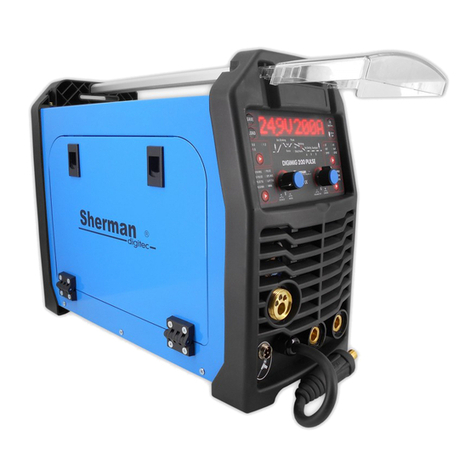
Sherman digitec
Sherman digitec DIGIMIG 2OO PULSE user manual
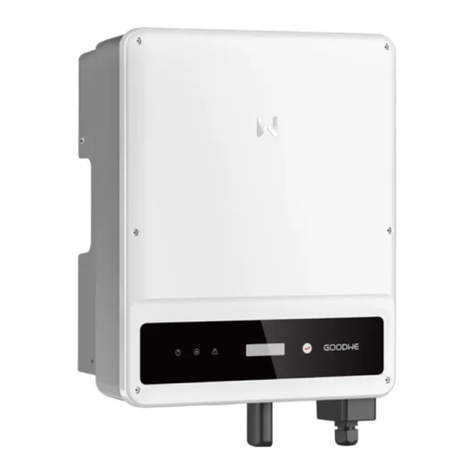
Goodwe
Goodwe MS Series user manual
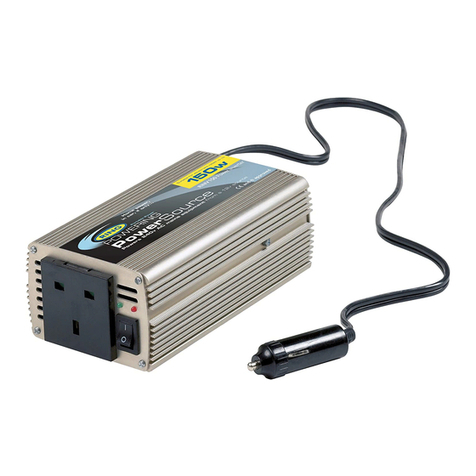
Ring Powering
Ring Powering PowerSource RINV150 user manual

Tektronix
Tektronix AWG5000 Series Programmer's manual
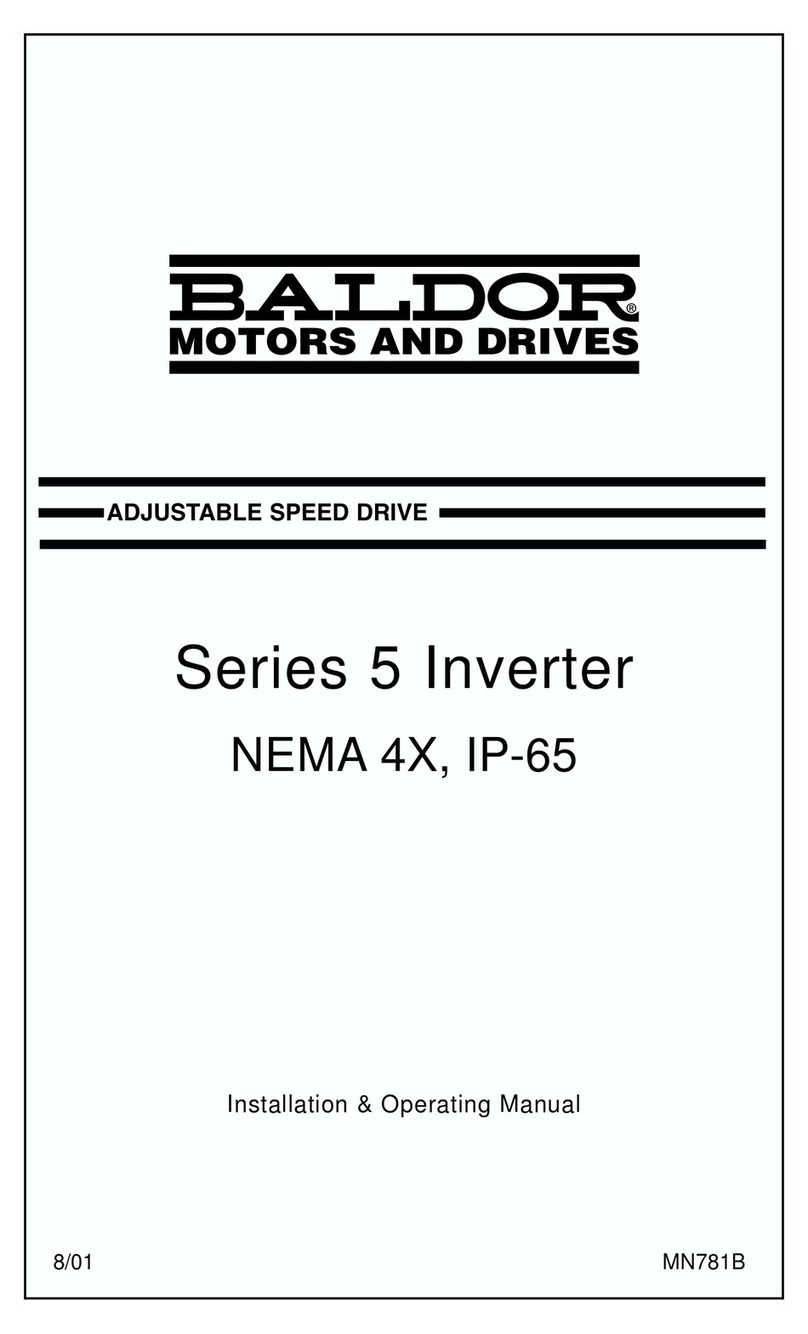
Baldor
Baldor Series 5 Inverter IP-65 Installation and operating manual
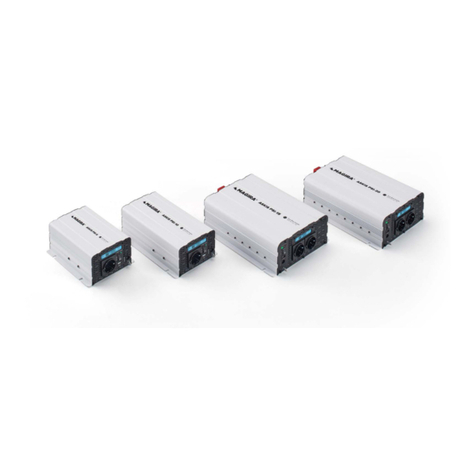
MAGIRA
MAGIRA ASKIS PSI-6 Assembly and operating instructions
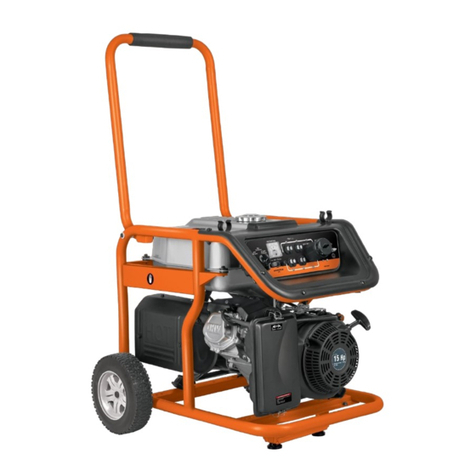
Truper
Truper GEN-80X manual
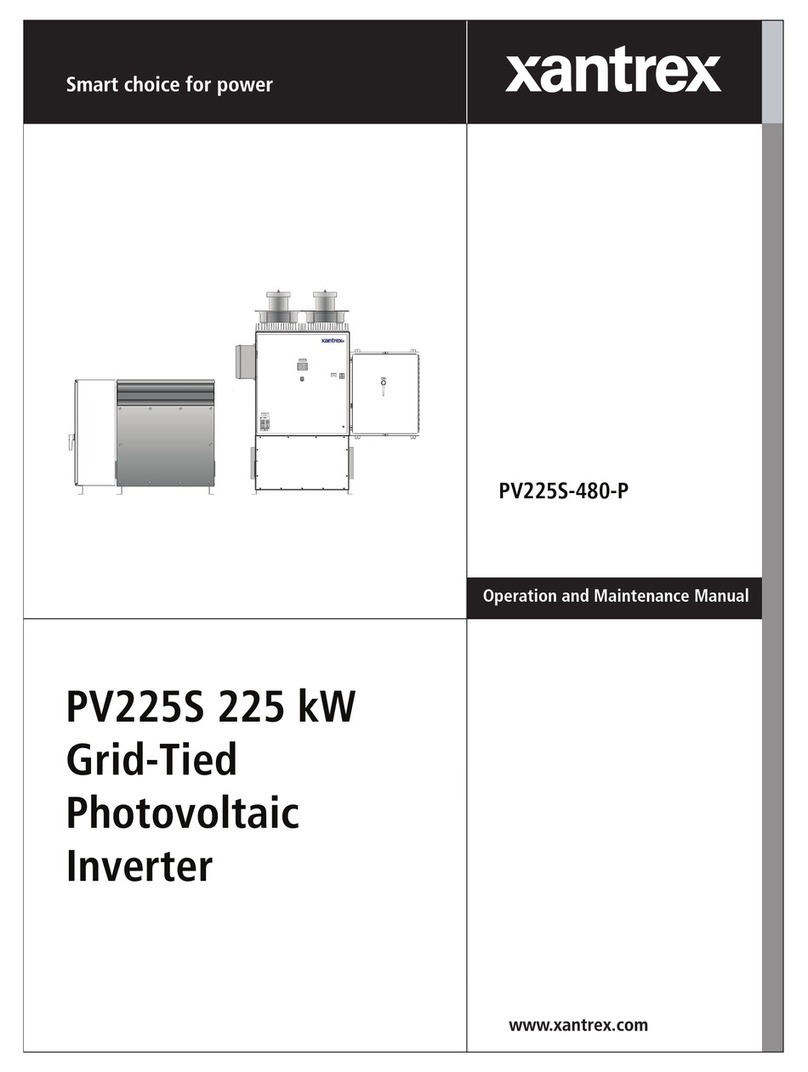
Xantrex
Xantrex PV225S-480-P Operation and maintenance manual
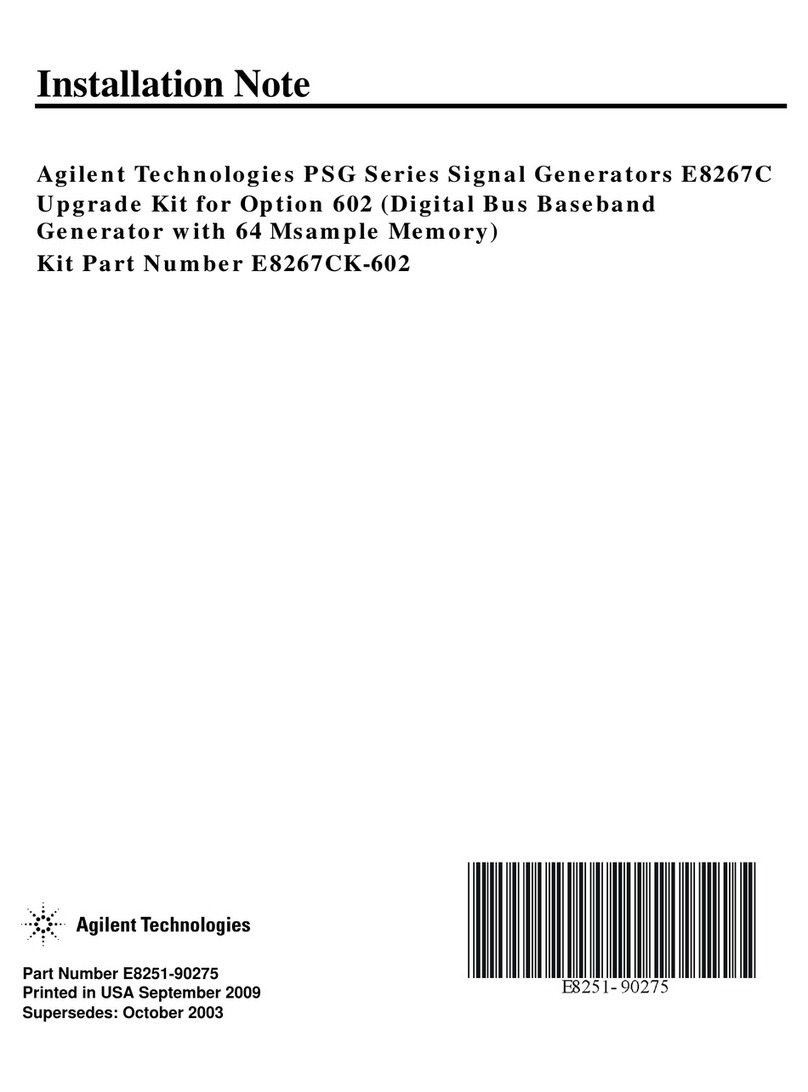
Agilent Technologies
Agilent Technologies PSG Series Installation note
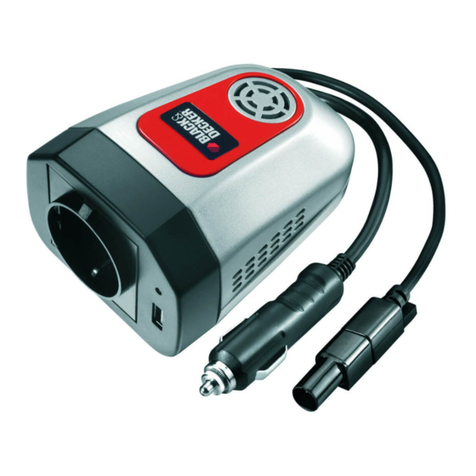
Black & Decker
Black & Decker BDPC100a manual
